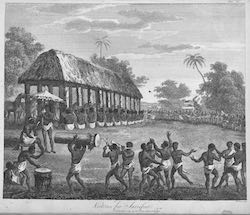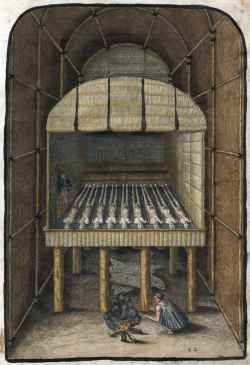Topic: 2. Sacrifice and religion: Comparisons, Antiquarians, Anthropology (16th-18th Century)
Religious sacrifices across various cultures and contexts sparked widespread interest in Early Modern Europe. As Christianity expanded into regions inhabited by "infidels" and "pagans", Europeans encountered a diverse array of sacrificial customs, ranging from the Sati rituals in India to the Aztec sacrifices in the Americas. This cross-cultural exposure captivated a wide audience, including theologians, philosophers, political thinkers, antiquarians, orientalists, missionaries, poets, artists, and even the general public. These encounters broadened the European understanding of sacrifice and led to a critical reassessment of classical and biblical sacrificial rites. This section includes:
- Sources: A selection of early modern printed materials, which include descriptions of the Americas, Asia, and Africa, alongside antiquarian and philological studies on religious sacrifice in classical antiquity and beyond. It also presents early modern works of ethnological observations and the first attempts to compare different sacrificial practices in various traditions and contexts, laying the groundwork for disciplines like the history of religions and anthropology.
- Iconographic Representations: A rich collection of images from the 16th to 18th centuries, illustrating a range of sacrificial rituals and practices as seen in different cultural and geographical contexts.
- Related Bibliography: An extensive bibliography spanning scholarly works from the 19th to 21st centuries, providing contemporary analyses and interpretations of these early studies and observations.
A threefold heresy: reassessing Jewish, Christian, and Islamic animal sacrifice in Late Antiquity
in: History of Religions, v. 58 (2019), issue 3: pp.251-176.
Simone da Trento
in: Dizionario biografico degli italiani, pp. -
: , 2018.
I papi e le accuse di omicidio rituale: Benedetto XIV e la bolla Beatus Andreas
in: Dimensioni e problemi della ricerca storica, v. 1 (2002), issue : pp.7-35.
Ricerche sull’accusa di omicidio rituale nel Settecento
in: Mediterranea. Ricerche storiche, v. 2 (2004), issue -: pp.81-104.
Une légitimité ‘flottante’: fête du sacrifice et Mawlid au Maghreb et dans l’Empire ottoman
in: Le Maghreb à l’époque ottomane / Al-Maghārib fī ‘l-ʿahd al-ʿUthmānī, pp. 21-32
Rabat: Université Mohammad V, 1995.
Ancora su Hinderbach e la “sua” creazione iconografica, con la riscoperta del ciclo simoniniano di S. Maria della Misericordia di Trento
in: Il Simonino. Geografia di un culto.Con saggi di Diego Quaglioni e Laura Dal Prà , pp. 17-52
Trento: Società di Studi Trentini di Scienze Storiche, 2012.
The Power of Sacrifice in Ancient Judaism and Christianity
in: Journal of Ritual Studies, v. 4 (1990), issue 2: pp.181-198.
Christian Sacrifice : the Judaeo-Christian Background before Origen
Washington: The Catholic University of America Press, 1978.
Is Christianity Sacrificial or Antisacrificial
in: Religion, v. 27 (1997), issue : pp. 231-243.
Sacrifice in Pagan and Christian Antiquity
London: T&T Clark, 2019.
Victims for Sacrifice (1793)
from: Dalzel, Archibad. The history of Dahomy, an inland Kingdom of Africa, London, T. Spilsbury and Son, 1793
Spanish Christian Sources of Information about Islam (Ninth-thirteenth centuries).
in: Al-Masaq, v. 15 (1994), issue : pp.365 - 384.
Naukeurige beschrijvinge der Afrikaensche gewesten
Amsterdam: van Meurs, 1676.
Andromache Mourning Hector (1783)
Museée du Louvre, Paris
in: Flesh Becomes Word: A Lexicography of the Scapegoat or, the History of an Idea, pp.
East Lansing, Michigan: Michigan State University Press, 2013.
0. General bibliography (19th-21th Century) 2. Sacrifice and religion: Comparisons, Antiquarians, Anthropology (16th-18th Century)
Molech : a God of Human Sacrifice in the Old Testament
Cambridge: Cambridge University Press, 1989.
The tomb of the weroans – An Algonquian burial house showing bodies on a raised platform and a priest squatting by a fire beneath the platform. (1590)
from: Thomas Hariot, Wunderbarliche, doch warhafftige Erklärung, von der Gelegenheit vnd Sitten der Wilden in Virginia, Franckfort am Mayn, Wechel-De Bry, 1590, plate 22




